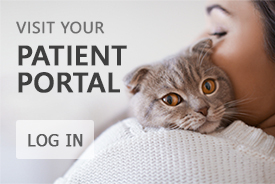Dogs and Diet
 Put healthy eating at the top of your dog’s resolutions! Diet and weight can top the list of New Year’s resolutions—for us and for our dogs. Whether you have four legs or two, being overweight has similar effects on the body: extra strain on the bones and joints, extra work for the heart and other organs, and an extra challenge to keep other health conditions, like diabetes, under control. But how do you know if your dog is eating too much, or perhaps too little? Here are some tips to help to make sure he’s eating just the right amount:
Put healthy eating at the top of your dog’s resolutions! Diet and weight can top the list of New Year’s resolutions—for us and for our dogs. Whether you have four legs or two, being overweight has similar effects on the body: extra strain on the bones and joints, extra work for the heart and other organs, and an extra challenge to keep other health conditions, like diabetes, under control. But how do you know if your dog is eating too much, or perhaps too little? Here are some tips to help to make sure he’s eating just the right amount:
- Consider your dog’s age and size. It makes sense an active, growing puppy needs more food than your 10-year-old. If you’ve been adjusting the amount you feed your fellow over the years, you’re probably doing it right.
- When it comes to numbers, count on your vet. Your vet can tell you how many calories your dog needs each day. And if you need to cut that down—or beef it up for an underweight animal—the vet can share tips to help make the transition easier—for you and for Fido.
- What feeding schedule fits your dog best? It might be convenient for you to serve up your dog’s meal once a day. But many dogs do better when the food’s given at a couple of times a day. For puppies and smaller dogs, several smaller meals keep them healthiest.
- Compared to canned food, dry food is usually lower in calories. So make canned food a treat, not the main course, if your pooch has a, well, pooch. With your vet’s advice, adjust the portions if your animal is underweight or recovering from an illness.
- Did you know there’s an organization that sets nutrition standards for pets at different stages of life? It’s the Association of American Feed Control Officials (AAFCO). If the package of the food you use mentions this group, they’re paying close attention to what’s in their food. If not, contact the food maker for details about calories and nutrition.
- You can ignore most advertising terms like “premium” and “gourmet.” As with people food, there’s no standard meaning for these terms. Instead, it might just mean it costs more.
- If you do make a change in the type of pet food, watch for signs that your pet’s doing fine. Diarrhea and throwing up are obviously not good. Gas might be a warning, too. If he’s having trouble with the change, but your vet has given the new diet the thumbs up, make the change more gradual. Give your pooch more of the old food and a little of the new food. Then substitute more and more of the new food over time. Over a week or more, the new food will be the new norm.
Like any good habit, it takes a while to make it stick. So promise yourself and your pup to take the time to learn any new mealtime routines. And in time, it’ll be old hat, and your pet will have the best chance to grow old with you.
Will your dog be having any diet changes this year? Tell us about it in the comment section below!
The post Dogs and Diet appeared first on Pet Assure Blog.
 Posted by dvmgalaxy
Posted by dvmgalaxy- Posted in Uncategorized
 Apr, 25, 2018
Apr, 25, 2018 Comments Off on Dogs and Diet
Comments Off on Dogs and Diet

 (770) 545-8077 | Fax: (770) 450-8573
(770) 545-8077 | Fax: (770) 450-8573


